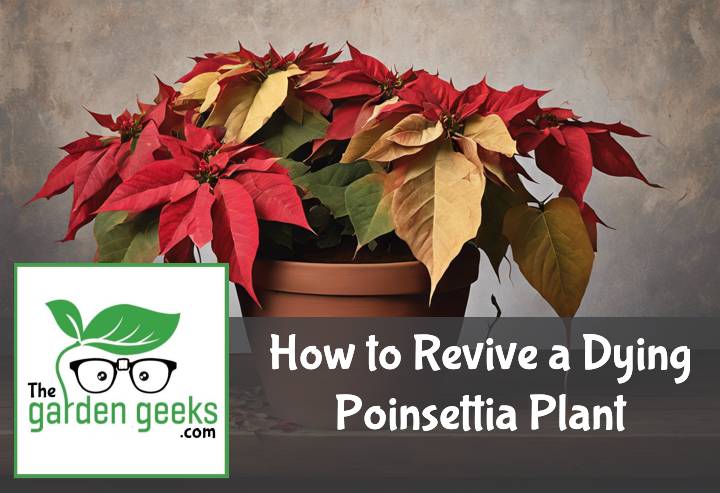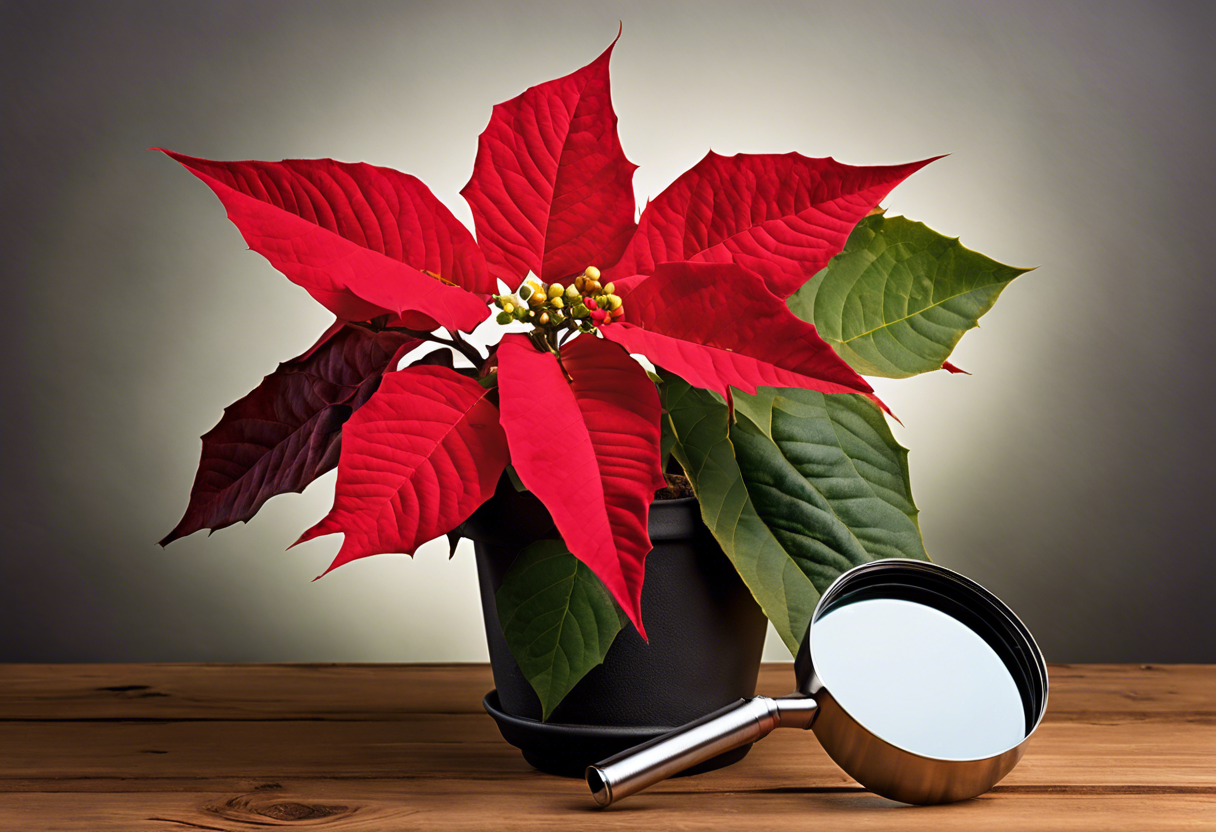Ever had that moment when you realize your once vibrant and beautiful Poinsettia plant is now looking a bit… well, worse for wear? Trust me, I’ve been there. It’s like finding out your favorite sitcom has been canceled. But don’t fret! With How to Revive a Dying Poinsettia Plant we’re about to turn that frown upside down!
So, buckle up my green-thumbed friends! We’re going on a rescue mission to bring back the color and life to your beloved Poinsettia. Keep reading about how to revive a dying poinsettia plant.
Key Takeaways
- Identify signs of a dying poinsettia, such as wilting, yellowing leaves, or lack of growth.
- Move the plant to a location with indirect sunlight and temperatures between 60-70°F.
- Water the plant only when the top inch of soil is dry. Overwatering can cause root rot.
- Fertilize monthly with a balanced houseplant fertilizer during growing season.
- Prune back hard in late winter/early spring to encourage new growth.
Understanding Poinsettia Plant Health
Getting to grips with poinsettia plant care is crucial for maintaining its health. It’s like being a plant doctor, you gotta know the symptoms to diagnose and treat your patient right! Now, let’s dive into the nitty-gritty of reviving dying poinsettias.
Identifying Signs of a Dying Poinsettia Plant
First off, knowing how to spot the signs of a sickly poinsettia is key. You don’t need a magnifying glass or anything fancy, just your peepers! Look out for wilting leaves or discoloration. These are telltale signs of dying poinsettias.
But wait, there’s more! Changes in your plant’s condition can also be a red flag. If your once vibrant poinsettia starts looking as sad as a rain-soaked kitten, it might be time to step up your game. Keep an eye out for these visual cues and changes in dying poinsettias.
Common Causes of Poinsettia Plant Deterioration
Now that we’ve covered the signs, let’s talk about what causes our festive friends to deteriorate. Sometimes it’s environmental factors messing things up. Too much sun? Not enough water? Your poinsettia might start throwing a tantrum!
Disease-related factors can also play a part in why our beloved plants go downhill. Just like us humans catching a cold, plants get sick too! So remember folks, understanding these causes for deteriorating poinsettias is essential if you want to learn how to revive a dying Poinsettia plant.
Assessing the Condition of Your Poinsettia Plant
Before you can figure out how to revive a dying poinsettia plant, it’s crucial to assess its condition. We’re talking about a thorough examination here, folks. A bit like a plant doctor, if you will. This involves checking two main areas: the soil and roots, and the leaves and stems.
Checking the Soil and Roots
First off, let’s get our hands dirty with some good ol’ soil checking. The poinsettia soil condition can tell us a lot about our festive friend’s health. If it’s too dry or too wet, we might have a problem on our hands. Now, onto the roots – these guys are like the heart of your poinsettia. Examining plant roots is essential as unhealthy ones often look dark and mushy—quite different from their healthy white and firm counterparts.
Examining the Leaves and Stems
Next up on our poinsettia examination, we’re looking at leaves and stems. These are like the face of your plant – they show signs when something’s off. When examining poinsettia stems and leaves, be on the lookout for wilting or discoloration as these could indicate an unhealthy poinsettia. Remember folks, in poinsettia care, every leaf matters!
Reviving Techniques for a Dying Poinsettia Plant
So, you’ve got a poinsettia that’s seen better days? Don’t fret! With some poinsettia care tips and a few reviving dying plants tricks up your sleeve, you can bring it back to life. Let’s dive into the nitty-gritty of how to revive a dying poinsettia plant.
Adjusting Watering Practices
First off, let’s talk water. Your poinsettia is like Goldilocks – it wants its water just right. Too much or too little can lead to trouble. If your plant is droopy with yellow leaves, you might be overdoing it on the H2O front. Fear not! An overwatered poinsettia recovery is possible.
Just ease up on the watering and make sure your pot has good drainage. On the flip side, if your plant looks dry and brittle, it could use more water. A little extra hydration can work wonders for an underwatered poinsettia treatment.
Modifying Light Exposure
Next up: light exposure. Poinsettias love light – but not too much direct sunlight. If your plant’s looking a bit pale, it might be craving more rays. Try moving it to a brighter spot in your home.
But remember: balance is key here too! Too much direct sunlight can scorch those beautiful leaves. So keep an eye on your plant and adjust accordingly for optimal poinsettia light requirements.
Changing Temperature Conditions
Last but not least: temperature conditions. Poinsettias are tropical plants, so they prefer warmer temperatures during the day (around 65-75°F) and cooler ones at night (55-60°F).
If your home is too cold or too hot, it could be causing stress for your plant. Try adjusting your thermostat or moving your poinsettia to a different room to find the ideal temperature for poinsettias. With a bit of tweaking, you can create the perfect environment for your plant’s revival!
Treating Diseases and Pest Infestations in Poinsettias
When it comes to How to Revive a Dying Poinsettia Plant, dealing with diseases and pests is crucial. Your poinsettia’s health can be severely compromised by these sneaky invaders, so let’s dive into how to tackle them head-on.
Identifying Common Diseases in Poinsettias
First things first, you gotta know what you’re up against. Poinsettia diseases are sneaky buggers that can creep up on your plant without much warning. To catch them early, keep an eye out for telltale signs like yellowing leaves or black spots – classic symptoms of an unhealthy poinsettia.
But don’t panic just yet! These symptoms could also indicate overwatering or lack of sunlight. So before you start treating for disease, make sure your plant isn’t just throwing a tantrum because it wants more sunbathing time.
Dealing with Pest Infestations
Now onto the creepy crawlies – pests! If you spot tiny bugs on your plant or see holes in the leaves, chances are you’re dealing with a pest infestation. But fear not, there are plenty of ways to send these uninvited guests packing!
Start by isolating your poinsettia from other plants to prevent the pests from spreading. Then give it a good shower – yes, literally! A strong spray of water can knock off many common pests.
If that doesn’t work, consider using an effective pest treatment like insecticidal soap or neem oil. Remember, consistency is key here – one treatment might not be enough to completely eradicate the problem.
And voila! With these tips in mind, maintaining healthy plants should be a breeze. Just remember: prevention is better than cure. Regularly check your poinsettia for signs of disease or pests, and act swiftly if you spot anything amiss.
Repotting and Pruning Your Poinsettia Plant
Reviving a dying poinsettia plant involves more than just watering and sunlight. It’s all about poinsettia care, which includes repotting potted plants and using the right pruning techniques. These steps are crucial for promoting healthy plant growth and ensuring your indoor beauty thrives.
When and How to Repot a Poinsettia
The best time to repot poinsettias is in spring, after the blooming season. This gives the plant plenty of time to settle before the next flowering period.
Start by choosing a new pot that’s slightly larger than the current one – this is important for root care during repotting. The new pot should be only an inch or two wider, as poinsettias prefer snug surroundings.
Next, prepare a soil mix suitable for poinsettias. They like well-draining soil, so consider a blend of peat moss, perlite, and sand.
Gently remove the plant from its old pot, taking care not to damage roots. Place it in the new pot and fill with soil until it reaches the same level as in the original pot.
Pruning Techniques for Healthy Growth
Pruning is essential for maintaining your poinsettia’s shape and promoting bushier growth. The best time to prune is in summer when new growth begins.
Start by identifying old or weak branches that aren’t contributing much to your plant’s health or appearance. Using sharp pruning shears, cut these back to about 4 inches from the main stem.
Next, look out for any diseased or dead leaves and remove them too. This will help prevent disease spread and promote healthier growth overall.
Remember: always sterilize your tools before pruning! This simple step can save you from accidentally spreading diseases across your beloved plants.
And there you have it! You’re now well on your way to mastering how to revive a dying poinsettia plant. Keep up the good work, and your poinsettia will be back in full bloom before you know it!
Maintaining Your Revived Poinsettia Plant
So, you’ve managed to revive your dying poinsettia plant. Congrats! But remember, How to Revive a Dying Poinsettia Plant is just the first step. Now comes the real deal – poinsettia plant maintenance. Keeping your revived poinsettia healthy requires regular care and preventive measures against future health issues.
Regular Care Routine for a Healthy Poinsettia
Your poinsettia’s post-revival life depends on a solid healthy poinsettia routine. It’s like sending your plant to the gym, but without the sweat!
Firstly, ensure it gets plenty of indirect sunlight daily. Just like us humans, these plants need their vitamin D too!
Next up is watering. You don’t want to drown it, but also don’t let it dry out completely. A good rule of thumb is to water when the top inch of soil feels dry.
Lastly, keep an eye on temperature and humidity levels. Poinsettias prefer cooler temperatures (around 65-70°F) and high humidity.
Preventive Measures Against Future Health Issues
As they say, prevention is better than cure! This holds true for preventing poinsettia health issues as well.
Start by inspecting your plant regularly for signs of pests or disease. Early detection can save you a lot of trouble down the line.
Another tip is to avoid over-fertilizing your plant. Too much of a good thing can be harmful!
And remember – stress isn’t good for anyone, including plants! Avoid drastic changes in light, temperature or watering routines to keep your poinsettia happy and healthy.
To Wrap Up
In the spirit of the holiday season, we’ve been like Santa’s elves, dishing out tips on How to Revive a Dying Poinsettia Plant. Turns out, it’s not rocket science! Just a little TLC and your poinsettia will be blooming like Times Square on New Year’s Eve.
So don’t just chuck your wilting poinsettia in the compost heap. Give it another shot. Remember, even Charlie Brown’s Christmas tree had a second act!





